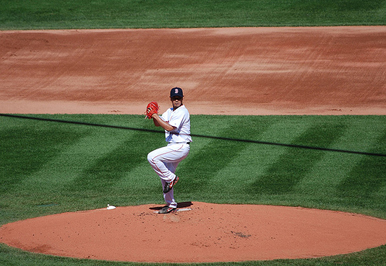Dice-K’s Mile-High Dilemma
Will Denver’s thin air melt the magic of the $52 million man?

When Red Sox pitcher Daisuke Matsuzaka takes the mound at the Colorado Rockies’ Coors Field tomorrow — at an altitude of about 5,280 feet — his biggest challenge may be the Bernoulli effect, which describes one of the many inflexible laws of physics. A broad, baseball-centric interpretation of Bernoulli’s troubling principle predicts that when Dice-K throws his very pricey pitches from a mound a mile above sea level, his curve will not curve, his sinker will not sink, and his cutter will not cut — at least, not in the style that the Dice Man, or his fans, is accustomed to. In fact, some physicists have claimed that a curveball thrown in Denver will break only two-thirds as much as a curveball thrown from Dice-K’s pitcher’s mound at Fenway.
BU Today talked to Bennett Goldberg, chairman of the College of Arts and Sciences physics department and a lifelong Sox fan, about the potentially disappointing consistency of the laws of fluid dynamics and why Dice-K’s customary magic may not go the distance.
BU Today: Can you explain why a curveball breaks?
Goldberg: A curveball breaks, diving down out of the way of the swinging bat, because the air pressure on top of the ball is greater than the air pressure on the bottom. A good curveball pitcher snaps his fingers and hand forward upon release of the pitch, causing the ball to have a lot of topspin. As the pitch flies toward home, cutting through the air, the velocity of air atop the ball is reduced by the layer of air dragged forward by the topspin, while the velocity of the air beneath is sped up by the extra air dragged backward.
How does Bernoulli’s principle enter into this?
Bernoulli’s principle is what makes a plane fly. Think of an airplane wing, with a faster velocity on the top edge — because of the longer surface — creating lower pressure relative to the bottom edge, and therefore creating lift. This principle can also be applied to baseball — as the velocity of air increases on the side of an object, the pressure reduces, pushing it in that direction.
How will all of this help or hurt Dice-K?
As the ball is spinning forward, it has a lower relative velocity of air on top than below, so there is more pressure on top than below. Thus, the ball experiences a downward force, causing it to curve down. If the rotation is not completely over the top, but has a sideways component, then the ball can break in either direction, left or right, as well as down.
This all works great in Boston or even in most ballparks in Japan. But there is a problem in Denver, and it’s not just the fans who won’t be cheering for Dice-K. Denver is a mile high, with much less atmosphere, lower pressure, and lower density, like up in an airplane.
Sounds like the lower density could be trouble.
Well, Bernoulli won’t help Dice-K in Denver. The problem is that the amount of pressure difference created by the spin depends directly on the density of the air itself. For a particular curveball rotation, the less dense the air, the less the difference in pressure. So, the ball spun the same way in Denver as at Fenway would experience less force and break less.
Art Jahnke can be reached at jahnke@bu.edu.